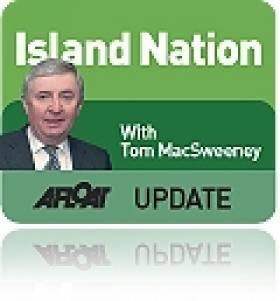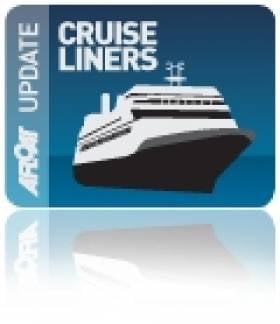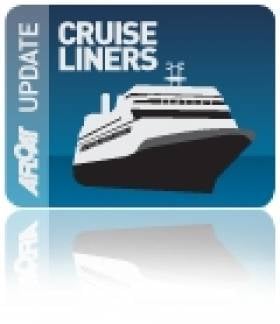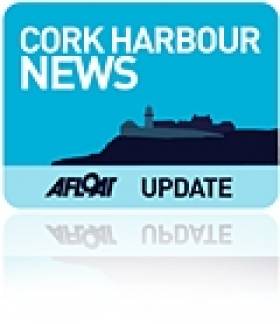Displaying items by tag: queen victoria
The 294m Queen Victoria cruise ship is in Belfast Harbour for dry-docking and is another luxurious vessel turning heads this week.
Putting the sheer scale into context, Queen Victoria as Belfast Telegraph writes, is around 25m longer than the Titanic or the equivalent of 20 buses back to back.
Operated by the Cunard Line, the cruise ship arrived from Tyneside on Tuesday and is capable of carrying more than 2,000 passengers and 980 crew.
Guests can enjoy a spectacular range of entertainment from a full theatre and ballroom to a spa and gym, pool, expanded sun deck and even a winter garden and 6,000 book library.
This time around no tourists are on board as the Queen Victoria is undergoing dry dock operations at Harland & Wolff as Afloat previously reported.
It is now the largest ever cruise ship to have ever dry-docked in a UK shipyard and the only ever Cunard ship to dry-dock in Belfast.
The 270m Aurora from P&O Cruises’ will also arrive in Belfast for dry dock operations.
#CunardCapitalCall – Queen Victoria, Cunard Line's elder 'Vista' class cruiseship called to Dublin Port in the late morning today as part of a 7-night 'Lusitania Remember' commemorative cruise from Southampton, writes Jehan Ashmore.
Having sailed overnight from Cobh where the main ceremony took place, this morning she passed Wicklow Head lighthouse at some 14 knots. From thereon she gradually reduced speed on the southern approaches to Dublin Bay.
Even at 90,049 tonnes the Italian built vessel with 2,194 passengers on board the 12-deck vessel has more graceful lines to other similar sized cruiseships.
She picked up a pilot off the cutter Liffey close to the South Burford Buoy.
When she further entered Dublin Bay offshore of Dun Laoghaire Harbour, this is where an anchorage call of her sister, Queen Elizabeth first took place in 2013.
In that same season the Cunard flagship cruise-liner Queen Mary 2 made her first appearance in Dublin Bay and again on that occasion she anchored off Dun Laoghaire.
The massive 151,000 tonnes 'liner' has not visited Dublin Port either, though the largest ever cruiseship is due to visit the port, MSC Splendida of 137,000 tonnes and longest at 333m is set to call to the capital port next Monday.
The record-breaking visit of MSC Cruises 'Fantasia' class cruiseship with 3,600 passenger capacity will also be a historic maritime milestone as this will be the biggest ship of any kind to visit Dublin Port.
Should one or both of the proposed cruise-berthing facilities totalling almost €50m be given the go-ahead in Dublin Port and neighbouring Dun Laoghaire Harbour, it would only be then that even bigger behemoths of the cruise industry will be able to berth within port.
In the meantime, the 294m Queen Victoria was able to turn around within Alexandra Basin. This part of the port is awaiting An Bord Pleanala decision on the proposed €200 million reconfiguration of the west basin that includes the dedicated cruise terminal. The proposed redevelopment would also require significant dredging including the channel leading to the port.
The 'Cunarder' came alongside Alexandra Basin's berth 33. This same stretch lining Ocean Pier within the basin is where MSC Splendida will notably berth 'astern' due to the existing confines of the port layout.
Such sized cruiseships and even larger in addition to increasingly bigger cargoships cannot use the existing turning circle which dictates ultimately the size of vessel using the port.
Why Sea Links Are More Important Than Air Links
#sealinks – In the current debate which has surfaced about the future of Aer Lingus, it is good to hear the realisation in all quarters, from politicians to business, economic and media commentators that Ireland is an 'island nation'. While the importance of air links is being highlighted, those same people could extend their thinking to the maritime links which keep this country alive in a way in which no air linkage can do.
This is emphasised in the leading story in the current edition of my radio programme, THIS ISLAND NATION which you can hear on this website, where I interview the first lady to become President of the Irish Institute of Master Mariners, the professional body for Shipmasters. Sea-going has been a male-dominated profession but Capt. Sinead Reen who lives in Crosshaven, Co.Cork, has done a lot to break that mould. She was also the first woman to qualify as a Deck Officer in Ireland and has served at sea on several types of vessels, including super tankers and cruise ships.
She describes in the interview how she chose a career at sea and, at a time when the Naval Service would not admit women, joined the Merchant Navy: "We are not seen by the general public because we are at sea, carrying the goods, the supplies, the imports, the exports, which this nation needs across the world's seaways. Without ships and seafarers this nation would find it difficult to exist." She discusses life at sea for a woman in a male environment aboardship and speaks of the great opportunities for employment at sea for both women and men. Her election underlines the opportunities of a career at sea for women in what has been a male-dominated profession.
It is an interview worth listening to, as is that about the commemorations planned in the Cork Harbour town of Cobh for the centenary of the sinking of the Lusitania in May.
Hendrik Verway, Chairman of Cobh Tourism, outlines the details of the commemorative plans. Cobh, where survivors of the Lusitania sinking by a German U-boat on May 7, 1915, were landed as well as the bodies of those who were killed in the tragedy, is planning ceremonies on the seafront at Cobh and a sail past by boats on the evening of May 7, with the vessels displaying a single white light to remember those who were killed. Two cruise ships will be in Cobh on the day. One of them, the Cunard's Queen Victoria, will be on a commemorative voyage and on Thursday afternoon, May 7, will sound her ship's whistle at the time at which the torpedo hit the Lusitania, to start a ceremony on the Cobh seafront . A quayside ceremony will start as the whistle sounds and which will conclude at 2.30 p.m., marking the time when the Lusitania sank beneath the waves. 1,198 passengers and crew died. Survivors were landed at Cobh, to where bodies of the dead were also brought and 169 buried. There were 764 survivors. Only 289 bodies were recovered. 169 are buried in the Old Cemetery in Cobh, 149 in three mass graves and 20 in individual plots. Amongst the commemorative events will be a series of lectures and an exhibition of photographs taken in Cobh, then called Queenstown, in the aftermath of the landing there of survivors and bodies by rescue vessels. Many of these photos have not been on public display before and have been digitised for exhibition from original glass plates photographed at the time, through the co-operation of the National Museum. It is also planned to re-enact the funeral of victims to the Old Cemetery in Cobh.
And in another interview on the programme, Paul Bourke of Inland Fisheries Ireland tells me that, for anglers, it has been a good year for the catching of specimen fish.
Fair Sailing...
Queen’s Namesake to Retrace Royal Visit
The 90,901 gross registered tonnes cruise ship is to depart her Hampshire homeport, where she is to similarly follow the monarch in that she is scheduled to make a port of call to Dublin first on 9 September and make a call to Cork afterwards.
With a length of 295m / 965-feet the vessel will dock in the centre of the capital port before she sails overnight to make a morning arrival at Cobh, the dedicated cruise terminal for the Port of Cork. She is scheduled to stay at the Cork Harbour town formerly named Queenstown until a 17.00 hour departure.
Her visit coincides with Cork Harbour Open Day, where visitors can view the impressive vessel from the quayside, for more details visit www.corkharbour.ie
Incidentally her near-sister Queen Victoria also called to Dublin in May and the remaining vessel of the Cunard fleet, the 'flagship' liner Queen Mary 2 is also to dock in Cobh three days later after Queen Elisabeth's visit.
- Cobh
- Cork Harbour
- port of Cork
- Cruise Liners
- Cork Harbour Open Day
- Ports and Shipping
- Cobh Cruise Terminal
- Queen Elizabeth II
- Cork Harbour News
- Port of Cork Company
- Cunard Line
- queen victoria
- Port of Cork News
- Queen Elizabeth
- Queen Mary 2
- QM2
- Cruise Liner news
- TransAtlantic Liners
- Cruise ships
- Irish cruiseship calls
- Queen's visit to Ireland
- QV
- QE
- Cunarders
- Cobh Cunarders
- Cobh cruise calls
- Cunard liners
- Cunard cruiseships
- Royal visit to Ireland
- Cobh cruise liners list
Three Masterpieces Set to Make an Impression in Dublin
Arcadia caters for the UK market and she is on a 13-night cruise which so far has included calls to North Shields, Tyneside, Invergordon, Shetland Isles, Glasgow, Belfast and Liverpool. After her call to the capital she heads for Cork and finally to St Peter Port, Guernsey.
Readers may note that the vessel is of the same design as of Cunard Line's Queen Victoria, which also called to Dublin in May and Cork. In fact Arcadia was to be given the regal name but the 2005 Italian built vessel was transferred from Cunard Line to P&O Cruises, which are under control of US-owned cruise giant Carnival Corporation.
Notable external features of the Arcadia are glass-fronted lifts, two pools, one with a skydome and an interior that is brimming with an art collection consisting of over 3,000 works. She has many facilities such as a three-tier palladium theatre, an intimate 30-seater cinema and gymnasium with an ocean view to inspire those exercising at sea. She was constructed in just twenty months by the Fincantieri shipyard, just outside Venice.
Likewise Eurodam has an extensive art collection theme that is based on the Dutch master's 'Golden Age' including "The Nightwatch, Two Minutes Later", a contemporary re-interpretation of Rembrandt's famous painting. In addition there are 17th-century watercolour maps by famed cartographer Johannes Vingboons.
Passengers on the 11-decked Signature-class can also enjoy the Pan-Asian restaurant and lounge surrounded by panoramic views, an explorer's lounge bar, an Italian restaurant adjacent to the lido, jewellery boutique, atrium bar, show lounge and a photographic and imaging-centre.
Last but not least to dock around lunchtime will be the 30,000 tonnes Ocean Princess, operated by Princess Cruises, another subsidiary of the Carnival Corporation. The 680-passenger / 181 m long vessel may be the smallest of tomorrow's callers and within the Princess Cruises fleet, but the former Tahitian Princess, which underwent an extensive dry-docking in Singapore last winter is well equipped with facilities.
She has a cabaret lounge, club restaurant and bar, casino bar, main pool and spa, steakhouse restaurant, panorama buffet, an Italian restaurant and the Tahitian Lounge. To see the work conducted at the dry-dock, you can view a slideshow by clicking HERE and to see the work in a completed state which also applied to her sister Pacific Princess, watch this VIDEO.
- Dublin Port
- port of Cork
- Dublin Bay News
- Princess Cruises
- P&O Cruises
- Cruiseships
- Port of Dublin
- Ports and Shipping News
- Cunard Line
- Dublin Port news
- Holland America Line
- queen victoria
- Fincantieri Shipyard
- Port of Dublin news
- Arcadia
- Eurodam
- Ocean Princess
- Irish cruiseship ports ofcall
- Dutch masters
- Rembrandt
- Onboard Art Collection
- Johannes Vingboons
Cork's Cruiseship's Call Schedule 2011
The inaugural call for this season was made last Monday by Cunard Line's Queen Victoria (90,049grt) and the four year-old vessel is to return for another visit on 5 May. Her slighty larger sister Queen Elizabeth (90,400grt) will make her maiden 'Irish' port of call on 10 September.
Last Autumn the 2,092 passenger cruiseship newbuild was 'floated-out' of the building dry-dock at Fincantieri's Monfalcone shipyard in Italy. At 294m long her hull is derived from the 'Vista' class series built for Carnival Corporation, owners of the Cunard Line.
Four days later the Cunard 'flagship' Queen Mary 2 (QM2) will also make an appearance. The 148,528grt French built vessel is the only designated cruise-liner in the world, the title was handed on from her predecessor, Queen Elizabeth II (QE2).
Throughout the career of the iconic liner, she made several calls to Cork (Ringaskiddy) while employed on the Atlantic 'liner' service between Southampton and New York.
On her farewell cruise QE2 made her first and only call to Cobh in 2008, the 70,327grt ship was meant to stay for a standard day-long visit but due to strong windy weather conditions in Cherbourg, she was prevented from docking and spent an un-scheduled overnight stay in the picturesque location.
The scheduling of all three 'Cunarders' to Cobh will be a first for the Port of Cork. Asides the Italian-built trio, there will be plenty more cruise callers lined up for the season, notably the Independence of the Seas, the largest cruiseship caller to an Irish port.
The Finnish built giant weighs 154,407 grt (some 6,000 tonnes larger than the liner QM2) and can carry 4,375 passengers.
Another large visitor will be the Azura at 115,055grt which can handle 3,100 passengers. She is the built to a design based from the 'Grand' class ships commissioned for Carnival Corporation's which also owns Princess Cruises.
The value of the cruiseship sector business to the island of Ireland this year is valued at €60m. The list below is a schedule of cruiseship calls to Cork Harbour (Cobh, Ringaskiddy and Cork city-centre quays).
Please note information is based in the order of ship's name first, passenger capacity (PAX), arrival date (time), location of berth and lastly departure date (time). For the most up-to-date information please refer to the Port of Cork Company website cruise call list.
ATHENA 580 Apr 27th at 08:00 Cobh Cruise Terminal
CELEBRITY ECLIPSE 3129 Apr 30th at 14:00 Cobh Cruise Terminal
May 1st at 16:00
INDEPENDENCE OF THE SEAS 4375 May 1st at 17:00 Cobh Cruise Terminal
May 2nd at 18:00
CELEBRITY ECLIPSE 3129 May 4th at 14:00 Cobh Cruise Terminal
DISCOVERY 689 May 4th at 07:00 Ringaskiddy DWB May 4th at 22:00
QUEEN VICTORIA 2000 May 5th at 20:02 Cobh Cruise Terminal
May 25th at 18:00
EMERALD PRINCESS 3592 May 6th at 08:00 Cobh Cruise Terminal
May 6th at 19:00
LE BOREAL 260 May 9th at 07:00 Cobh Cruise Terminal May 9th at 17:00
GRAND PRINCESS 3300 May 15th at 06:00 Cobh Cruise Terminal
May 15th at 17:00
COSTA DELIZIOSA 2826 May 17th at 07:00 Cobh Cruise Terminal
May 17th at 19:00
CROWN PRINCESS 3114 May 24th at 07:00 Cobh Cruise Terminal
May 24th at 17:00
ROTTERDAM 1668 May 26th at 07:00 Cobh Cruise Terminal
May 26th at 17:00
SILVER WHISPER 1668 May 28th at 09:00 Cobh Cruise Terminal
May 28th at 23:00
LE DIAMANT 200 Jun 22nd at 06:00 Cobh Cruise Terminal
Jun 22nd at 19:00
ASTOR 656 Jun 27th at 06:00 Ringaskiddy DWB
SILVER CLOUD 296 Jun 27th at 07:00 Cobh Cruise Terminal
Jun 27th at 19:00
MINERVA 352 Jul 1st at 07:00 Cobh Cruise Terminal
LE DIAMANT 200 Jul 7th at 06:00 North Custom House Quay
Jul 7th at 23:30
AURORA 1950 Jul 7th at 11:30 Cobh Cruise Terminal
Jul 7th at 23:00
ATHENA 580 Jul 15th at 08:00 Cobh Cruise Terminal
Jul 15th at 17:00
SILVER CLOUD 296 Jul 18th at 07:00 Cobh Cruise Terminal
Jul 18th at 19:00
SPIRIT OF ADVENTURE 470 Jul 19th at 06:00 North Custom House Quay
Jul 19th at 18:00
ROTTERDAM 1668 Jul 19th at 07:00 Cobh Cruise Terminal
Jul 19th at 17:00
AZURA 3100 Jul 19th at 08:00 Ringaskiddy DWB
Jul 19th at 18:00
DAWN PRINCESS 2342 Jul 24th at 06:00 Cobh Cruise Terminal
Jul 24th at 17:00
CROWN PRINCESS 3114 Jul 26th at 07:00 Cobh Cruise Terminal
Jul 26th at 17:00
MARINA- Jul 27th at 07:00 Cobh Cruise Terminal
Jul 27th at 18:00
AIDABLU 2580 Aug 11th at 07:00 Cobh Cruise Terminal
Aug 11th at 18:00
MAASDAM 1613 Aug 13th at 06:00 Cobh Cruise Terminal
Aug 13th at 15:00
SEVEN SEAS VOYAGER 730 Aug 17th at 07:00 Cobh Cruise Terminal
Aug 17th at 15:00
CROWN PRINCESS 3114 Aug 18th at 07:00 Cobh Cruise Terminal
Aug 18th at 17:00
LE DIAMANT 200 Aug 19th at 06:00 Cobh Cruise Terminal
Aug 19th at 23:30
CLIPPER ODYSSEY 128 Aug 19th at 07:00 Cobh Cruise Terminal
Aug 19th at 21:00
ATHENA 580 Aug 22nd at 07:30 Cobh Cruise Terminal
Aug 22nd at 17:00
AIDABLU 2580 Aug 25th at 07:00 Cobh Cruise Terminal
Aug 25th at 18:00
LE DIAMANT 200 Aug 26th at 06:00 Cobh Cruise Terminal
Aug 26th at 23:00
ARCADIA 2388 Aug 29th at 07:00 Cobh Cruise Terminal
Aug 29th at 17:00
AZAMARA JOURNEY 702 Aug 31st at 08:00 Cobh Cruise Terminal
COSTA DELIZIOSA 2826 Sep 1st at 07:00 Cobh Cruise Terminal
Sep 1st at 18:00
LE DIAMANT 200 Sep 3rd at 07:00 North Custom House Quay
Sep 3rd at 17:00
PRINSENDAM 843 Sep 3rd at 09:00 Cobh Cruise Terminal
Sep 3rd at 18:00
DISCOVERY 689 Sep 4th at 08:00 Cobh Cruise Terminal
Sep 4th at 18:00
SILVER CLOUD 296 Sep 5th at 07:00 Cobh Cruise Terminal
Sep 5th at 18:00
JEWEL OF THE SEAS 2500 Sep 6th at 08:00 Cobh Cruise Terminal
Sep 6th at 16:00
SILVER WHISPER 388 Sep 10th at 06:00 Cobh Cruise Terminal
Sep 10th at 18:00
QUEEN ELIZABETH 2092 Sep 10th at 08:00 Ringaskiddy DWB
Sep 10th at 17:00
OCEAN COUNTESS 884 Sep 14th at 06:30 Ringaskiddy DWB
Sep 14th at 16:30
QUEEN MARY 2 2592 Sep 14th at 08:00 Cobh Cruise Terminal
Sep 14th at 17:00
OCEAN COUNTESS 884 Sep 16th at 07:30 Cobh Cruise Terminal
FRAM 500 Sep 28th at 07:00 Cobh Cruise Terminal
Sep 28th at 18:00
SAGA RUBY 668 Dec 15th at 07:00 Cobh Cruise Terminal
Dec 15th at 23:00
- Cruiseships
- Cruise Liners
- Cork Harbour
- Cork Harbour News
- Port of Cork Company
- Port of Cork News
- Cobh
- Cobh Cruise Terminal
- Cunard Line
- Carnival Corporation
- Princess Cruises
- queen victoria
- Queen Elizabeth
- Queen Elizabeth II
- QE2
- Queen Mary 2
- QM2
- Independence of the Seas
- Royal Carribean Cruise Line
- RCCL
- Fincantieri
- Grandclass
- Vistaclass
- Ports and Shipping News
Rare Royal Sailing Art to be Auctioned
A rare sailing painting of the Visit of Queen Victoria's visit to Cork Harbour by George Mounsey is to be auctioned at an Irish auction next Wednesday. The Woodward's auction will offer a number of items but the sailing art depicting the Queen and Prince Albert on board the royal yacht in August 1849 is one of few records of the event. It is estimated the painting will fetch between €20,000-30,000. With the probability of the first visit to Ireland by HRH Queen Elizabeth, the context of the above visit to Cork in 1849 is worth examining according to the auctioneer.


































































